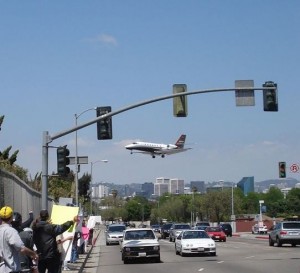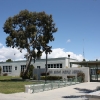Airport
Airport Commission to Tackle Airport Visioning at Its Next Meeting on Monday, April 23, 7:30 PM, at City Hall
The Airport Commission has planned a workshop format discussion of future options for SMO. The workshop will include:
- A review of legal agreements, including how various Federal/City agreements impact potential future options for various
parcels of land at the airport – this seems to indicate that the City has more power to control some portions of the airport
land than others. - An overview of the City’s proprietary powers with regard to the City’s jurisdiction over future airport uses.
- Economic analysis of SMO – For all of you who wanted to know if the airport is a money maker for the City, this will be
your opportunity to find out. - From Cal Poly Pomona’s College of Environmental Design, a presentation of ideas on re-purposing airport land.
- Summary of results from CASMAT and OPA online Surveys.
This will be a VERY informative meeting. We encourage all who are interested in the Airport’s future to attend.
City Completes Phase II of the Airport Visioning Process — City Council Presentation on May 8
Phase II consisted of discussion groups, which commenced in January and ended on March 24. Participants included residents from Santa Monica and Los Angeles, as well as pilots from as far away as Temecula. The results of these discussion groups will be presented to the City Council by consultant Daniel Iacafano on May 8.
Considerable negative feedback was expressed by the community after consultant presentations to City Council in October 2011. These presentations consisted of a summary of Point C interviews with airport stakeholders, an Economic Impacts Analysis by HR&A, and a report on “Options for the Future” by The RAND Corporation. The consultant presentations can be viewed on the airport web site: http://www.smgov.net/departments/airport/
Needless to say, there was skepticism going into Phase II. Off to a slow start, with no shows and scant sign-ups for weekday sessions, FOSP requested that the City add more discussion groups on the weekends and evenings to accommodate potential participants’ work schedules. FOSP outreach consisted of door step flyers, group email contacts and, finally, personal emails, phone calls, and in-person invitations.
FOSP has received mixed reviews of residents’ experiences in the group discussions. There were significant complaints that pro-aviation attendees had the same “talking points” at every meeting, as if their comments were planned ahead of time. Some participants felt there was not enough time spent on discussion of future options at the airport. Others felt they had a positive experience in their discussion groups.
For more information regarding the city’s Airport Visioning process visit: http://smovisioning.org/
CASMAT Survey Results Posted
CASMAT (Community Against Santa Monica Airport Traffic) conducted an online survey regarding options for the Santa Monica Airport (SMO) future from November 2011 to March 2012. Over 1000 questionnaires were completed. Results are posted on the CASMAT web site at http://www.casmat.org/. The results indicated an overwhelming desire for the operations at SMO be eliminated or reduced, in spite of an attempt by part of the aviation community to skew results by claiming to be residents despite the fact that their submittals were coming from far flung locations around the world (Germany, Guatemala, Israel, Italy, Spain, United Arab Emirates, United Kingdom, etc.). Most people from Santa Monica, Venice, Mar Vista, and West Los Angeles who took the survey indicated that SMO’s continuing to operate “as is” in 2015 would not be acceptable.
Santa Monica Airport Visioning Process Begins
As the operating agreement between the FAA and the City of Santa Monica regarding the Santa Monica Airport approaches its expiration in 2015, the City has begun a process to determine the options available for the airport’s future. The airport consists of 227 acres located at the southeast corner of the City’s borders. The 5000 ft runway is embedded in a residential area, and the environmental and safety impacts have been a longtime concern for airport neighbors. In addition to the runway itself, the airport property hosts aviation-related businesses, non-aviation business, airport staff offices, aircraft tie-downs (parking spaces), aircraft hangers, restaurants, artist studios, sports playing fields, a dog park, a theatre, and some SMC classrooms. The City has engaged the services of three consultant firms to conduct an airport visioning process. The RAND Corporation will produce a study of potential development concepts and applications for the aviation and non-aviation land. HR&A Advisors will analyze the economic and fiscal impacts of the airport. PointC will formulate and manage an extensive community process regarding the range of possibilities for the Airport’s future. This public outreach process will include all stakeholders, including residents, business owners, aviation and non-aviation interests. Phase I of the process will involve information gathering. Phase II will consist of a comprehensive public input process. After a full range of options are identified with the associated costs and benefits, the City will then undertake Phase III, a deliberative planning process for the future of the Airport.

Jet flying over Bundy Drive to land at Santa Monica Airport
Phase I: February to September 2011
- HR&A will prepare a study of Airport’s economic impact.
- RAND will prepare a report and analysis of general aviation airport best practices, potential alternative layouts, operational configurations and uses.
- Point C will identify stakeholders, formulate a public process plan that will include all the stakeholders, and design presentations and formats to disseminate the information collected and produced by HR&A and RAND.
Phase II: October 2011 to January 2012
- A program of public workshops will be conducted. These meetings will be designed to include a broad range of participants.
- Meetings will be scheduled throughout this period to ensure all interested members of the public have the opportunity to participate.
- Recommendations will become part of the public dialogue report.
Phase I: February to September 2011
- City Council will begin the deliberative phase with presentations from RAND and HR&A on their reports and with a full review and discussion of the comments and recommendations from the Phase II public input process.
- City Council will consider appropriate policies and actions.






